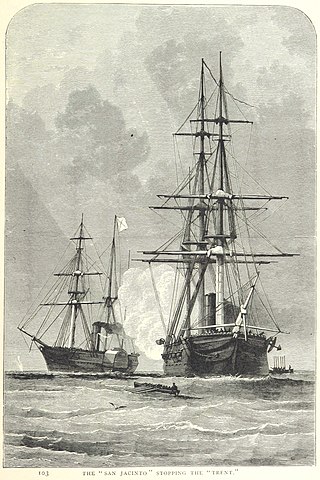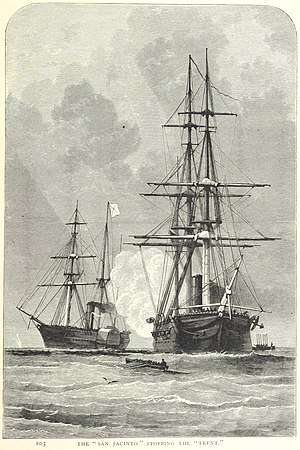
The Trent Affair was a diplomatic incident in 1861 during the American Civil War that threatened a war between the United States and Great Britain. The U.S. Navy captured two Confederate envoys from a British Royal Mail steamer; the British government protested vigorously. The Lincoln administration ended the incident by releasing the envoys.

Red Funnel, the trading name of the Southampton Isle of Wight and South of England Royal Mail Steam Packet Company Limited, is a ferry company that carries passengers, vehicles and freight on routes between the English mainland and the Isle of Wight. High-speed foot passenger catamarans, known as Red Jets, run between Southampton and Cowes, while vehicle ferries run between Southampton and East Cowes.

The first USS San Jacinto was an early screw frigate in the United States Navy during the mid-19th century. She was named for the San Jacinto River, site of the Battle of San Jacinto during the Texas Revolution. She is perhaps best known for her role in the Trent Affair of 1861.

The Pacific Mail Steamship Company was founded April 18, 1848, as a joint stock company under the laws of the State of New York by a group of New York City merchants. Incorporators included William H. Aspinwall, Edwin Bartlett, Henry Chauncey, Mr. Alsop, G.G. Howland and S.S. Howland.

The Royal Mail Steam Packet Company was a British shipping company founded in London in 1839 by a Scot, James MacQueen. The line's motto was Per Mare Ubique. After a troubled start, it became the largest shipping group in the world in 1927 when it took over the White Star Line. The company was liquidated and its assets taken over by the newly formed Royal Mail Lines in 1932 after financial trouble and scandal; over the years RML declined to no more than the name of a service run by former rival Hamburg Süd.

USS Clyde was a paddle steamer captured by the Union Navy during the American Civil War, and commissioned to patrol Florida waters. She had been built in 1861 in Glasgow, Scotland as the Clyde passenger steamer Neptune, but sold in 1863 to become a blockade runner, making two successful round trips to Mobile, Alabama before capture. After the war she was sold to mercantile interests as Indian River, but lost shortly afterwards.

HMS Himalaya was built for the Peninsular and Oriental Steam Navigation Company as SS Himalaya, a 3,438 gross register ton iron steam screw passenger ship. She was purchased by the Royal Navy in 1854 for use as a troopship until 1894 and was then moored in the Hamoaze, Devonport to serve as a Navy coal hulk until 1920, when sold off. She was sunk during a German air attack on Portland Harbour in 1940.

PS Ryde is a paddle steamer that was commissioned and run by Southern Railway as a passenger ferry between mainland England and the Isle of Wight from 1937 to 1969, with an interlude during the Second World War where she served as a minesweeper and then an anti-aircraft ship, seeing action at D-Day. After many years abandoned on moorings at Island Harbour Marina on the River Medina, she was purchased by the PS Ryde Trust in late 2018, with the intention of raising money for her restoration. That project was abandoned in January 2019.

HMS Driver was a Driver-class wooden paddle sloop of the Royal Navy. She is credited with the first global circumnavigation by a steamship when she arrived back in England on 14 May 1847.

The Britannia class was the Cunard Line's initial fleet of wooden paddlers that established the first year round scheduled Atlantic steamship service in 1840. By 1845, steamships carried half of the transatlantic saloon passengers and Cunard dominated this trade. While the units of the Britannia class were solid performers, they were not superior to many of the other steamers being placed on the Atlantic at that time. What made the Britannia class successful is that it was the first homogeneous class of transatlantic steamships to provide a frequent and uniform service. Britannia, Acadia and Caledonia entered service in 1840 and Columbia in 1841 enabling Cunard to provide the dependable schedule of sailings required under his mail contracts with the Admiralty. It was these mail contracts that enabled Cunard to survive when all of his early competitors failed.

The Arago was a wooden hulled, brig-rigged, sidewheel steamer built in 1855 by Westervelt & Sons at New York, New York. Chartered by the Union Army in the Army Transport Service, during the American Civil War for use as a troop transport and in operation with the South Atlantic Blockading Squadron throughout the war, Arago was the ship that returned the United States flag to Fort Sumter in April 1865. Returned to transatlantic passenger and freight service after the Civil War, she was sold to the Peruvian government in 1869.
The Hayle and Bristol Steam Packet Company operated steam ship services between Hayle, Ilfracombe and Bristol in the mid nineteenth century. Confusingly from 1848 to 1860, the company name was used by two separate operators.
PS Earl of Arran was a passenger vessel operated by the Ardrossan Steamboat Company from 1860 to 1871 and the West Cornwall Steam Ship Company from 1871 to 1872
SS Equity was a freight vessel built for the Co-operative Wholesale Society Limited in 1888.
SS Ralph Creyke was a passenger and freight vessel built for the Goole Steam Shipping Company in 1879.
PS Killingholme was a passenger and cargo vessel built for the Great Central Railway in 1912.

PS Sandown was a passenger vessel built for the Southern Railway in 1934 and later served with distinction in the Royal Navy during the Second World War.
The Solent Sea Steam Packet Company, later the Solent Steam Packet Company, operated ferry services between Lymington and Yarmouth on the Isle of Wight between 1841 and 1884.

HMS Devastation was a Royal Navy Driver class steam sloop, unusually powered as a paddle steamer designed by Sir William Symonds and launched in 1841. She saw no major action but did have some noteworthy commanders.

Adriatic was a wooden-hulled, side-wheel steamship launched in New York in 1856. She was conceived as the largest, fastest, most luxurious trans-Atlantic passenger liner of her day, the pride of the Collins Line. At the time of her launch she was the largest ship in the world.













